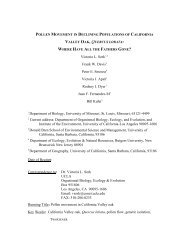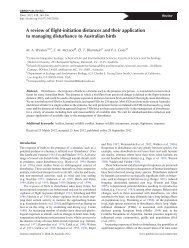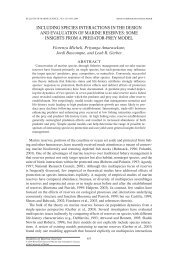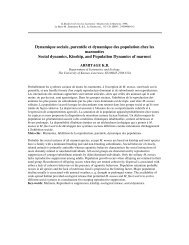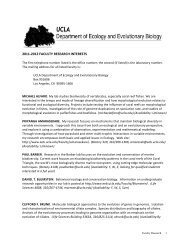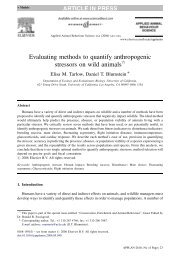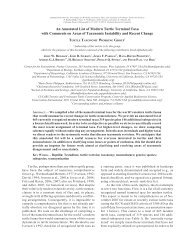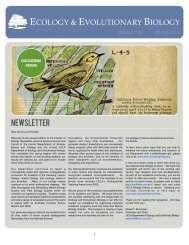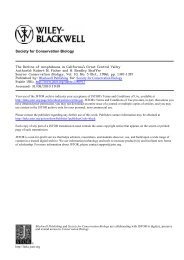Automated sound recording and analysis techniques for bird ...
Automated sound recording and analysis techniques for bird ...
Automated sound recording and analysis techniques for bird ...
You also want an ePaper? Increase the reach of your titles
YUMPU automatically turns print PDFs into web optimized ePapers that Google loves.
Bird Conservation International (2008) 18:S163–S173. ß BirdLife International 2008doi:10.1017/S0959270908000415 Printed in the United Kingdom<strong>Automated</strong> <strong>sound</strong> <strong>recording</strong> <strong>and</strong> <strong>analysis</strong><strong>techniques</strong> <strong>for</strong> <strong>bird</strong> surveys <strong>and</strong> conservationT. SCOTT BRANDESSummaryThere is a great need <strong>for</strong> increased use <strong>and</strong> further development of automated <strong>sound</strong> <strong>recording</strong><strong>and</strong> <strong>analysis</strong> of avian <strong>sound</strong>s. Birds are critical to ecosystem functioning so <strong>techniques</strong> to makeavian monitoring more efficient <strong>and</strong> accurate will greatly benefit science <strong>and</strong> conservationef<strong>for</strong>ts. We provide an overview of the hardware approaches to automated <strong>sound</strong> <strong>recording</strong> aswell as an overview of the prominent <strong>techniques</strong> used in software to automatically detect <strong>and</strong>classify avian <strong>sound</strong>. We provide a comparative summary of examples of three general categoriesof hardware solutions <strong>for</strong> automating <strong>sound</strong> <strong>recording</strong> which include a hardware interface <strong>for</strong> ascheduling timer to control a st<strong>and</strong>alone commercial recorder, a programmable <strong>recording</strong> device,<strong>and</strong> a single board computer. We also describe examples of the two main approaches toimproving microphone per<strong>for</strong>mance <strong>for</strong> automated recorders through small arrays ofmicrophone elements <strong>and</strong> using waveguides. For the purposes of thinking about automated<strong>sound</strong> <strong>analysis</strong>, we suggest five basic <strong>sound</strong> fragment types of avian <strong>sound</strong> <strong>and</strong> discuss a varietyof <strong>techniques</strong> to automatically detect <strong>and</strong> classify avian <strong>sound</strong>s to species level, as well as theirlimitations. A variety of the features to measure <strong>for</strong> the various call types are provided, alongwith a variety of classification methods <strong>for</strong> those features. They are discussed in context ofgeneral per<strong>for</strong>mance as well as the monitoring <strong>and</strong> conservation ef<strong>for</strong>ts they are used in.IntroductionAcoustic communication in <strong>bird</strong>s is rich <strong>and</strong> lends itself to one of the primary ways in which<strong>bird</strong>s make their presence known to each other, as well as one of the most direct ways <strong>for</strong>humans to detect them, often at times when they are difficult to see. Further, the vast majorityof <strong>bird</strong>s have songs or calls that serve as a species-specific acoustic signature that readilyannounces their presence. This abundance of <strong>sound</strong> provides a readymade source of in<strong>for</strong>mationthat can be used to explore the composition of avian diversity in particular regions of interest.There is a great need <strong>for</strong> avian monitoring in conservation ef<strong>for</strong>ts. Birds are the most speciosegroup of terrestrial vertebrates <strong>and</strong> they encompass a wider range of habitats than any othergroup of vertebrates on the planet. Birds are particularly abundant <strong>and</strong> diverse in the tropics,consisting of both generalists <strong>and</strong> specialists, as well as migrants <strong>and</strong> local breeders. They areimportant consumers at several trophic levels; they eat fruit, grains, nectar, insects, <strong>and</strong> vertebrates.As such wide-ranging consumers, <strong>bird</strong>s contribute to a variety of important ecosystem functions. Asinsectivores, they play a role in controlling insect populations (Holmes 1990; Holmes et al. 1979), asfrugivores they are particularly important plant dispersal agents (Snow 1971, 1981, Howe <strong>and</strong>Smallwood 1982), <strong>and</strong> as nectar consumers they are important pollinators (Carpenter 1978,Feinsinger <strong>and</strong> Colwell 1978, Proctor et al. 1996). Since <strong>bird</strong>s play such varied <strong>and</strong> widespread rolesin ecosystem functions, they are vulnerable to both human induced habitat change (Becker <strong>and</strong>Agreda 2005, Canterbury <strong>and</strong> Blockstein 1997) <strong>and</strong> global climate change (Pounds et al. 1999), <strong>and</strong>as a result many species are declining (Collar et al. 1994).
T. S. Br<strong>and</strong>es S164Bird <strong>sound</strong> is the most efficient means <strong>for</strong> surveying <strong>bird</strong>s, particularly in the tropics (Parker1991, Riede 1993, Kroodsma et al. 1996). A variety of methods <strong>for</strong> monitoring <strong>and</strong> assessing<strong>bird</strong>s are available (Ralph <strong>and</strong> Scott 1981, Verner 1985, Bibby et al. 1992, <strong>and</strong> Ralph et al. 1993)<strong>and</strong> three widely used <strong>techniques</strong> are mist-netting, point counts, <strong>and</strong> transect counts. Of these,only mist-netting does not include the use of passive acoustics. Point <strong>and</strong> transect counts thatmake use of <strong>bird</strong> <strong>sound</strong>s are more efficient than mist-nets (Parker 1991, Angehr et al. 2002).Acoustic surveying lends itself to rapid assessment programmes (RAP) which quickly evaluatethe biodiversity of specific regions (Riede 1998). This is largely because <strong>bird</strong>s are heard more oftenthan seen or trapped. This translates into not only more accurate species counts, but also fasterestimations of biodiversity. Parker (1991) describes how in seven days he recorded the vocalizationsof 85% of the 287 species of avifauna his team of seven ornithologists inventoried after 54 days ofintensive field work within a 2 km 2 area in Amazonian Bolivia, which included 36,804 mist-net hours.The most significant drawback to point <strong>and</strong> transect counts is the reliance on highly trainedpersonnel <strong>for</strong> making identifications of species <strong>and</strong> the inherent subjectivity of their data due toskill level. This can make comparisons between data from different personnel unreliable (Angehret al. 2002). However, the use of acoustic recorders can greatly reduce this variability, <strong>and</strong> somestudies have suggested that acoustic <strong>recording</strong>s alone are preferable to trained personnel withoutrecorders, since <strong>recording</strong>s are more consistent <strong>and</strong> achievable (Haselmayer <strong>and</strong> Quinn 2000,Hobson et al. 2002, Rempel et al. 2005). Additional st<strong>and</strong>ardisation in data collection is possibleby using automated recorders, particularly those that can record on a programmable schedule.Although it is often not possible to directly count the number of calling individuals this way,there are methods available <strong>for</strong> estimating associated in<strong>for</strong>mation useful <strong>for</strong> conservationresearch. For instance, abundance estimates are needed to make use of many metrics ofbiodiversity change, <strong>and</strong> automated recorders scheduled to record at the same time <strong>and</strong> spacedfar enough apart to not record the same individuals can be used to provide these estimatesthrough occupancy modelling (Royle <strong>and</strong> Nichols 2003, Mackenzie et al. 2005).Having this process automated can involve more than just having the <strong>recording</strong> itselfautomated; it also includes automating the <strong>sound</strong> <strong>analysis</strong> <strong>and</strong> species identification. This automationcan take the <strong>for</strong>m of simple template matching or more advanced <strong>techniques</strong> such as those used inhuman speech recognition. There is still much work to be done with automatic call recognition (ACR)software, particularly with classifying a wide range of <strong>bird</strong> species recorded in a natural setting <strong>and</strong>detecting novel calls, but promising inroads have been made <strong>and</strong> some ACR methods have beenshown to work in suitable settings. The remainder of this work is organized as follows. A summary ofuseful hardware approaches to automating acoustic <strong>recording</strong> of <strong>bird</strong> <strong>sound</strong> is provided. Then, anoverview of approaches to automated <strong>analysis</strong> of <strong>bird</strong> <strong>sound</strong> is given followed by concluding thoughts<strong>and</strong> direction of future research.Hardware <strong>for</strong> automated <strong>recording</strong> of <strong>bird</strong> <strong>sound</strong>sHardware <strong>for</strong> scheduled <strong>recording</strong>sThe basic components of hardware <strong>for</strong> use in automated <strong>recording</strong> of <strong>bird</strong> <strong>sound</strong> are themicrophone, audio recorder, power supply, mechanism <strong>for</strong> initiating <strong>and</strong> ending <strong>recording</strong>s, <strong>and</strong>a weather-proof housing <strong>for</strong> the equipment. The hardware described here consists of devicesdesigned to operate autonomously in remote locations <strong>and</strong> record high quality digital <strong>sound</strong>stored on hard drives or flash memory cards at scheduled intervals of time. There are threeprimary approaches to developing this sort of <strong>recording</strong> apparatus. Here I provide details <strong>and</strong>examples of all three of these approaches. While the examples are by no means exhaustive, theyare a representative overview of the three main categories of the current technology available,<strong>and</strong> a list of vendors is provided just be<strong>for</strong>e the reference section. The first but least sophisticatedapproach is to design a scheduling timer through a hardware interface to control a st<strong>and</strong>alonecommercial recorder. This is the least desirable option since it typically involves tampering with
<strong>Automated</strong> <strong>sound</strong> <strong>recording</strong> <strong>and</strong> <strong>bird</strong> surveysS165the recorder <strong>and</strong> using it in a way not intended by the engineers who designed it, but it is theleast expensive. A commercially available example of this type of device is the programmabletimer circuit board by Nauta, an Italian company, which is adapted to control the M-audioMicrotrack 24/96 recorder. Though the field-ready product they sell is intended <strong>for</strong> cetaceans,they also sell their timer board by itself <strong>and</strong> provide detailed instructions <strong>for</strong> its installation <strong>and</strong>use, <strong>and</strong> it can be readily adapted <strong>for</strong> use in <strong>recording</strong> <strong>bird</strong>s. This device saves <strong>sound</strong> as noncompressedwave-files. Devices that save <strong>sound</strong> as mp3 files or other compressed <strong>for</strong>mats are lessattractive since data is lost. This compression <strong>for</strong>mat is designed to be minimally detectable tohuman ears, so researchers should do a comparative <strong>analysis</strong> on their <strong>sound</strong>s recorded in bothlossless <strong>and</strong> lossy <strong>sound</strong> <strong>recording</strong> <strong>for</strong>mats to verify that their target <strong>sound</strong>s are not degraded bythe <strong>recording</strong> <strong>for</strong>mat chosen, <strong>and</strong> not just listen to the <strong>recording</strong>s.A more elegant approach is to write software <strong>for</strong> a programmable <strong>recording</strong> device, such as apersonal digital assistant (PDA) or a smart phone. This approach is preferable to the previous onein that the <strong>recording</strong> device does not need to be tampered with <strong>and</strong> it lends itself to morecomplicated <strong>recording</strong> schedules. For instance, a <strong>recording</strong> schedule starting 30 minutes be<strong>for</strong>esunrise, as opposed to a fixed clock time such as 06h00, is more readily accomplished throughsoftware running on a PDA than with an external timer circuit board. A further benefit to thesedevices is that they are designed to be user-friendly <strong>and</strong> the scheduling software can be written<strong>for</strong> use by non-technical personnel. An example of this type of device is one built byConservation International (Br<strong>and</strong>es 2005). In their device, an HP iPac 5550 is used to record<strong>sound</strong> at scheduled intervals <strong>and</strong> store it on 4 GB flash memory cards (this scheduling software isavailable at no cost from the Tropical Ecology Assessment <strong>and</strong> Monitoring Network atConservation International or by sending an email request to the author). The PDA approach isnot as power efficient as it could be, in that connecting it to an external battery supply begins theprocess of recharging the on-board Li-ion battery instead of powering the unit directly.Conservation International’s PDA recorders require about 17 amp-hours of battery life to record10 minutes of <strong>sound</strong> daily <strong>for</strong> two weeks, which can be accomplished with eight high-capacity NiMHbatteries. Both of these approaches are susceptible to changes in hardware by the manufacturers inthe <strong>for</strong>m of firmware or operating system updates <strong>and</strong> much work might need to be done to keep upwith the latest hardware available. This approach in particular has been used in monitoringnocturnal <strong>sound</strong>s in tropical <strong>for</strong>ests, but it could readily be used to monitor diurnal avifauna.The most sophisticated of the approaches presented here is to develop recorders with singleboardcomputers. This provides the developer with the most control in creating a device designed<strong>for</strong> the sole purpose of <strong>recording</strong> <strong>sound</strong> autonomously. To do this properly requires a dedicatedengineering lab, <strong>and</strong> a few labs now offer their products commercially <strong>for</strong> purchase or <strong>for</strong> lease.An experienced lab in this area is the Bioacoustics Research Program (BRP) at the Cornel Lab ofOrnithology. For many years they have been developing autonomous <strong>recording</strong> units (ARUs)<strong>for</strong> both terrestrial <strong>and</strong> underwater use. They currently offer these units <strong>for</strong> lease <strong>and</strong> cancustom design the sampling schedule to fit particular requirements. They store <strong>sound</strong> onto an 80 GBhard drive <strong>and</strong> can be deployed <strong>for</strong> months at a time. BRP also makes ARUs that record in stereo <strong>and</strong>use a GPS time-stamp, enabling the <strong>recording</strong>s to be used to find the position of animals <strong>and</strong> tracktheir movement. These recorders have been used <strong>for</strong> many years in the ongoing ef<strong>for</strong>t to find theIvory-billed Woodpecker Campephilus principalus (Fitzpatrick et al. 2005), <strong>and</strong> this has contributedto their continued improvement. A private company, Wildlife Acoustics, now offers a single-boardcomputer type of recorder commercially. It stores 80 hours of <strong>sound</strong> <strong>and</strong> can be kept in the field <strong>for</strong> amonth or longer on a single set of batteries. They have recently been used to monitor breedingCerulean Warblers Dendroica cerulea by the U.S. Forest Service.Microphones <strong>for</strong> automated <strong>recording</strong>Microphones <strong>for</strong> h<strong>and</strong>-held field <strong>recording</strong>s can be quite specialized, <strong>and</strong> the same is true ofthose <strong>for</strong> automated recorders. Typically, microphones <strong>for</strong> h<strong>and</strong>held <strong>recording</strong>s are far more
T. S. Br<strong>and</strong>es S166sensitive to <strong>sound</strong> in the direction they are pointed, preventing <strong>sound</strong>s incident at other anglesfrom being recorded as loudly. This type of microphone works well when a researcher wants torecord a particular individual that is singing. With automated recorders, the opposite is true, inthat omni-directional microphones are used instead of directional microphones since there is noway of knowing ahead of time where a <strong>sound</strong> will originate. Single-element omni-directionalmicrophones can be effective, but there are two basic approaches to increase their effectiveness.The first is to use a small array of microphone elements to create a more sensitive beam-patternthan that of a single microphone element. An example of this is the linear 16-elementmicrophone array (less than 15 cm in length) designed by BRP <strong>for</strong> use with their ARUs. Thesearrays <strong>for</strong>m a beam-pattern in the shape of a toroid (Figure 1, a). They are most sensitive to<strong>sound</strong> around the axis of the microphone array, <strong>and</strong> least sensitive in the direction pointing fromeach end. By placing this microphone array in a canopy hanging downward, it is sensitive to<strong>sound</strong> originating from any direction within the canopy, <strong>and</strong> is least sensitive to <strong>sound</strong>originating directly above or below it. A second approach to improving omni-directionalmicrophone gain is to use a specially designed waveguide to collect <strong>and</strong> amplify the <strong>sound</strong> be<strong>for</strong>eit reaches the microphone element (Figure 1, b). River Forks Research Corporation developed anomni-directional waveguide <strong>for</strong> the purpose of <strong>recording</strong> <strong>bird</strong>s (Hobson et al. 2002). Their designconsists of two 26.67 cm (10.5 inch) plastic discs stacked 2.54 cm (1 inch) apart that have ahyperbolic curve in their inner surface that is used to amplify incoming <strong>sound</strong>. The microphoneelement is placed at the centre, between the discs. They are mounted horizontally, but aresensitive to <strong>sound</strong> above <strong>and</strong> below the waveguide as well as <strong>sound</strong> originating from all otherangles. They are well suited to record <strong>bird</strong>songs, but are more expensive than most high qualityh<strong>and</strong>-held microphones.Figure 1. (a.) Toroid shaped beam-pattern <strong>for</strong> a small microphone array <strong>and</strong> (b.) the hyperbolicwaveguide. The beam-pattern indicates how sensitive the microphone is to <strong>sound</strong> as a function ofangle. In both of these designs, <strong>sound</strong> originating from all around the microphone can bedetected, but they are least sensitive to <strong>sound</strong> directly above or below.
<strong>Automated</strong> <strong>sound</strong> <strong>recording</strong> <strong>and</strong> <strong>bird</strong> surveysS167<strong>Automated</strong> <strong>analysis</strong> of <strong>bird</strong> <strong>sound</strong>sBird <strong>sound</strong>s as a whole are as complex <strong>and</strong> varied as any group of non-human animals. For thepurposes of thinking about automated <strong>sound</strong> <strong>analysis</strong>, there are at least five broad categories ofdiscrete <strong>sound</strong> unit shapes that compose <strong>bird</strong> <strong>sound</strong>s (Figure 2). These <strong>sound</strong> units includesegments with constant frequency, frequency modulated whistles, broadb<strong>and</strong> pulses, broadb<strong>and</strong>with varying frequency components, <strong>and</strong> segments with strong harmonics. Even if thissummarized all of the complexity of <strong>bird</strong> <strong>sound</strong>s, this degree of variety in <strong>sound</strong> types would bea challenging task <strong>for</strong> a single automated call recognition algorithm. Additionally, <strong>bird</strong> <strong>sound</strong>soften include complexity in the <strong>for</strong>m of variations <strong>and</strong> themes of combinations of the basic <strong>sound</strong>shapes shown in Figure 2. If we think of those discrete chunks of <strong>sound</strong> as syllables, then thiscomplexity can range from simple repeated sequences of syllables to complex sequences ofsyllables with patterns that seldom repeat. We can add to this complexity with field situationsthat make detection <strong>and</strong> classification more challenging when encountering duets, choruses ofoverlapping songs, intentional call masking, <strong>and</strong> vocal mimicry. Finally, difficulty in creatingautomated classifiers can arise from species that have regional dialects, very large songrepertoires, <strong>and</strong> even improvisational songs.At the least, automatic call recognition of <strong>bird</strong> songs is complex, but much has been done tomake it viable when focused on a limited number of species. The <strong>analysis</strong> process has twoprimary parts, call feature extraction <strong>and</strong> call classification based on the features. The choice ofwhich features to measure depends largely on the characteristic structure of the target calls,whereas the choice of classifier depends on the way in which the feature measurementsdistinguish the various types of target calls. A list of features <strong>and</strong> classifiers commonly used on avariety of call-types is provided in Table 1.Typically, features are chosen such that they provide in<strong>for</strong>mation about a call that ischaracteristic about it, so that similar calls will be grouped together, <strong>and</strong> ones dissimilar will berecognized as being different. Features that consist of direct parameter measurements of a call,such as peak frequency <strong>and</strong> b<strong>and</strong>width, work well <strong>for</strong> constant frequency or simple frequencymodulated calls. A variety of simple parameter measurements have been shown effective innocturnal flight call monitoring of migrants (Farnsworth et al. 2004, Farnsworth <strong>and</strong> Russell,2007, Hüppop et al. 2006). In particular, Schrama et al. (2008) chose seven direct measurementsof calls to automate a process <strong>for</strong> recognizing nocturnal flight calls of migratory <strong>bird</strong>s: callFigure 2. Spectrogram (frequency vs. time) displays of five broad categories of discrete <strong>sound</strong>unit shapes that compose <strong>bird</strong> <strong>sound</strong>s <strong>for</strong> the purpose of thinking about species-level automated<strong>sound</strong> recognition: (a) constant frequency (Wood Thrush Hylocichla mustelina); (b) frequencymodulated whistles (Canon Wren Catherpes mexicanus); (c) broadb<strong>and</strong> pulses (Brewer’sSparrow Spizella breweri); (d) broadb<strong>and</strong> with varying frequency components (Canon Wren); (e)<strong>and</strong> segments with strong harmonics (Blue Jay Cyanocitta cristata).
T. S. Br<strong>and</strong>es S168Table 1. Comparison of the various features used to detect the basic <strong>sound</strong> unit shapes of <strong>bird</strong> <strong>sound</strong> inFigure 2, along with the various classification methods used with those features. This list serves as asummary of all the <strong>bird</strong> <strong>sound</strong> recognition methods referenced in this paper. Interestingly, none of themethods target call type ‘d’, broadb<strong>and</strong> with varying frequency components.Target Call Type in Figure 2 Feature Extraction Classification Methoda, b direct time <strong>and</strong> frequencymeasures from target callsBayesian classifier, Euclidi<strong>and</strong>istancec pulse-to-pulse duration neural networksc <strong>sound</strong> template dynamic time warping, minimumcross-correlation thresholdemulti-spectral estimates with FFT multivariate statistics<strong>and</strong> related functionsa, b, e peak frequency contour vector Bayesian classifier, dynamic timewarping, hidden Markov models,neural networksb, e cepstral coefficients dynamic time warping, Gaussianmixture models, hidden Markovmodelsduration, highest frequency, lowest frequency, loudest frequency, average b<strong>and</strong>width, maximumb<strong>and</strong>width <strong>and</strong> average frequency slope. If the call type clusters resulting from features arelinearly separable, then simple Bayesian classifiers can be used. Otherwise, neural networks canbe employed to attempt to separate the call types. Terry <strong>and</strong> McGregor (2002) successfully used<strong>and</strong> compared three basic types of neural networks to identify individual Corncrakes Crex crex.Since Corncrakes utter calls that consist of broad-b<strong>and</strong> pulses with distinct timing, they foundthat the pulse-to-pulse timing is the important feature to measure. In a novel approach, Tanttuet al. (2006) created their own type of frequency contour vector to use in self-organizing neuralnetworks to recognize simple frequency modulated flight calls from crossbills Loxia spp. Byfocusing only on the peak harmonic in any multi-harmonic calls, they were able to extract thefeatures needed to make correct identifications.Another method that has been successful is template matching. In its basic <strong>for</strong>m, this is doneby selecting an example <strong>sound</strong> as a template with which to find other instances of this <strong>sound</strong>.This approach can work if the <strong>sound</strong> has little variation among individual <strong>bird</strong>s <strong>and</strong> if thebackground <strong>sound</strong>s are similar in both the template <strong>and</strong> the field <strong>recording</strong>s. This is the approachused in the ongoing ef<strong>for</strong>t to find the Ivory-billed Woodpecker. Though template matchingtypically works better with longer signals, it is appropriate to try with Ivory-billed Woodpeckerssince they have simple calls that have little variation <strong>and</strong> they also make distinct double rap<strong>sound</strong>s on trees. Additionally, there are not many sample <strong>recording</strong>s of them, so a method withan adjustable threshold <strong>for</strong> positive identification allows a wider variation of similar calls to bemarked <strong>for</strong> more detailed <strong>analysis</strong>. A more sophisticated approach is to use dynamic timewarping (DTW) in the template matching (Anderson et al. 1996). DTW is per<strong>for</strong>med byexp<strong>and</strong>ing <strong>and</strong> contracting the template in time to better fit songs given a little slower or fasterthan the template <strong>sound</strong>. This allows <strong>for</strong> a wider range of detections than the st<strong>and</strong>ard templatematching, but it only works on species which have relatively consistent songs or calls.Additionally, it requires a template <strong>for</strong> each <strong>sound</strong> to identify, so it works most efficiently withspecies that have very small <strong>and</strong> consistent repertoires. Schrama et al. (2008) have shown successusing DTW to better detect nocturnal migrants by their flight call.An entirely different approach is to use stochastic sequence modelling <strong>techniques</strong> to make<strong>sound</strong> classifications based on short-time measurements of <strong>sound</strong> features <strong>and</strong> how thosefeatures change in time. This is accomplished with hidden Markov models (HMM), a techniquewidely used <strong>for</strong> human speech recognition. The features most commonly used <strong>for</strong> human speechrecognition are calculated with cepstral coefficients <strong>and</strong> derivatives thereof. These coefficients
<strong>Automated</strong> <strong>sound</strong> <strong>recording</strong> <strong>and</strong> <strong>bird</strong> surveysS169capture the rich harmonic structure of human voice well, <strong>and</strong> the sequences of their changethroughout the course of speaking a word can be modelled accurately with HMMs. Thesemethods have been successfully used to classify <strong>bird</strong> songs (Kogan <strong>and</strong> Margoliash 1998, Trifaet al. 2008), particularly with <strong>bird</strong>s that have a rich harmonic structure in their songs. Cepstralcoefficients have some drawbacks though. In particular, they are very susceptible to noise <strong>and</strong>can lead to poor classification of <strong>sound</strong>s that overlap in time, even if they do not overlap infrequency. Notably, Trifa et al. (2008) had success using HMMs to recognize ant<strong>bird</strong>s(Thamnophilidae) in a Mexican rain<strong>for</strong>est. The species they chose do not have calls with strongharmonics <strong>and</strong> their <strong>recording</strong>s have some degree of background noise. Another approach usedwith human speech recognition that has been explored with <strong>bird</strong> <strong>sound</strong> is the use of Gaussianmixture models (GMM) (Kwan et al. 2004). In this approach, <strong>sound</strong>s are treated as acombination of normal distributions of <strong>sound</strong> elements, each with different densities or weights.Each test <strong>sound</strong> being classified has a different set of these mixtures <strong>and</strong> a classification is madebased on the most likely combination estimated from <strong>sound</strong>s used to train the model. Thismethod has been shown to be successful with a small data set of <strong>bird</strong> species, but as with theother approaches, it is susceptible to noise.Perhaps the most common problem <strong>for</strong> automated identification of <strong>bird</strong> <strong>sound</strong> recorded innatural settings is noise. Not only can the presence of noise limit the ability <strong>for</strong> <strong>bird</strong>songdetection, it can also lead to misclassifications (Baker <strong>and</strong> Logue 2003). Far <strong>and</strong> away the mostcommon method <strong>for</strong> dealing with noise is to limit the <strong>sound</strong> <strong>analysis</strong> to the frequency b<strong>and</strong>swhere the target <strong>sound</strong>s are found by using b<strong>and</strong>-pass filters, as used by Farnsworth <strong>and</strong> Russell(2007) <strong>and</strong> Hüppop et al. (2006) to eliminate wind <strong>and</strong> ocean wave noise. Un<strong>for</strong>tunately, thesemethods can also eliminate many of the target <strong>sound</strong>s if they overlap the high noise part of thespectrum. Another technique is to use a sample of the background <strong>sound</strong> from a <strong>recording</strong> <strong>and</strong>subtract it out from the entire <strong>recording</strong>. This is most effective when the background noise isconstant <strong>and</strong> not broad-b<strong>and</strong>, <strong>and</strong> it has a limited utility with field <strong>recording</strong>s. A differentapproach is to apply a threshold filter at different frequency b<strong>and</strong>s (Schrama et al. 2008). Thishas the effect of selecting <strong>sound</strong>s that are above the specified <strong>sound</strong> level threshold <strong>for</strong> <strong>analysis</strong>,but problems can arise with calls that vary in intensity. A different method to extract calls in anoise rich environment uses image processing of spectrograms (Br<strong>and</strong>es et al. 2006). In thisapproach, after a preliminary step of applying a threshold filter customized <strong>for</strong> each frequencyb<strong>and</strong>, a slight blur filter is applied to the spectrogram. This has the effect of washing outbackground noise, <strong>and</strong> applying a <strong>for</strong>m of signal reconstruction to the calls, enabling a moreconsistent <strong>for</strong>m of feature extraction. Though this method was tested mostly with cricket <strong>and</strong>frog calls from tropical <strong>for</strong>est <strong>recording</strong>s, it works equally well with detecting <strong>and</strong> classifyingavian <strong>sound</strong>s that are constant in frequency such as those from tinamous (Tinamidae).Methods to detect <strong>and</strong> classify avian <strong>sound</strong> in high noise environments have concentrated onextracting the peak frequency components from the songs. Tanttu et al. (2006) <strong>and</strong> Hüppop et al.(2006) were successful at detecting flight calls by using only the peak spectral components ofcalls that contained harmonics. Likewise, Chen <strong>and</strong> Maher (2006) use a method to track spectralpeaks to classify <strong>bird</strong> <strong>sound</strong> recorded at airports. Spectral peak tracks are <strong>for</strong>med by segmentingthe <strong>sound</strong> into short overlapping segments, measuring the peak frequency of that segment <strong>and</strong>matching it with the peak found in the adjacent <strong>sound</strong> segment. These tracks are then stored in adatabase <strong>and</strong> used as a template to classify the test <strong>sound</strong>s. This approach has shown to besuccessful with classifying some <strong>bird</strong> species, but often makes a classification only of general calltype. In a different approach, a wide range of <strong>bird</strong> <strong>sound</strong>s can be detected <strong>and</strong> classified with amethod that uses a noise reduction step through spectrogram image processing <strong>and</strong> adds to it apeak frequency contour feature measurement that is modelled with HMMs to classify frequencymodulated whistles <strong>and</strong> complex sequences of them (Br<strong>and</strong>es 2008). Here, features are notextracted with cepstral coefficients, but instead with measurements of frequency, frequencyb<strong>and</strong>width, <strong>and</strong> the change in these parameters from the previous time step. As with Trifa et al.(2008), this method has been shown to be effective at classifying groups such as ant<strong>bird</strong>s;
T. S. Br<strong>and</strong>es S170however, it has the advantage of using features that are less susceptible to background noisetypical of tropical <strong>for</strong>ests than cepstral coefficients, <strong>and</strong> is a method better suited to autonomous<strong>recording</strong>s. Additionally, Br<strong>and</strong>es (2008) employs hierarchical HMMs that find patterns atmultiple levels of organization. Bottom-level HMMs detect calls, while higher level HMMsdetect sequences of calls. This added pattern search ability allows <strong>for</strong> a much larger variety of calltypes to be searched <strong>for</strong>.There is a variety of software available that can be used to automatically detect particular <strong>bird</strong><strong>sound</strong>s, with proper training. None of them are comprehensive in their ability <strong>and</strong> they are alldependent on having moderate background noise <strong>and</strong> a good training set of <strong>bird</strong> <strong>sound</strong>s,particularly the software designed to work with human speech. We provide here a short list offree software; web addresses are provided with the reference list. For nocturnal flight calls ofmigrants, Farnsworth <strong>and</strong> Russell (2007) used software from Old<strong>bird</strong>, Inc. Kogan <strong>and</strong>Margoliash (1998) <strong>and</strong> Trifa et al. (2008) used software titled the Hidden Markov ModelToolkit (HTK) from the Entropic Research Laboratory that is a software library written in C++.One software package particularly useful in developing avian <strong>sound</strong> recognition algorithms isthe Extensible Bioacoustics Tool (XBAT) developed <strong>and</strong> distributed by the Bioacoustics ResearchProgram at the Cornell Lab of Ornithology (Figueroa <strong>and</strong> Robbins 2008). This software runs as atoolbox within the MATLABH mathematical programming environment. XBAT provides anenvironment designed to run st<strong>and</strong>ard detection algorithms, such as template matching, as wellas an environment to test <strong>and</strong> develop custom designed <strong>bird</strong> <strong>sound</strong> recognition algorithms.Concluding thoughtsThe advent of this hardware <strong>and</strong> software is drawing bioacoustics into an ever increasinglyimportant role in conservation. Conservation relies on documented <strong>sound</strong> <strong>recording</strong>s as a recordof a species’ acoustic signature as well as to document particular field records of observations thatcan be revisited. Likewise, automatic call recognition software relies on documented <strong>sound</strong><strong>recording</strong>s, as they are only as good as the <strong>sound</strong> <strong>recording</strong>s used to train them. This places aparticularly high importance on the role <strong>and</strong> necessity of <strong>sound</strong> libraries. Two extensive librariesare the Macaulay Library of Natural Sound at Lab of Ornithology at Cornell University <strong>and</strong> thelibrary at the Borror Laboratory of Bioacoustics at Ohio State University. These libraries housemany <strong>recording</strong>s from <strong>bird</strong>s around the world, but they still lack many of the secondary callswhich are not heard as often, <strong>and</strong> more ef<strong>for</strong>t is needed in collecting <strong>and</strong> donating <strong>recording</strong>s of<strong>bird</strong> calls that are more seldom heard (Kroodsma et al. 1996).In many ways, the technology <strong>for</strong> automated <strong>recording</strong> of avian <strong>sound</strong> has arrived <strong>and</strong> thetechnology <strong>for</strong> automated <strong>analysis</strong> is burgeoning. This automation will be a big boon <strong>for</strong> science<strong>and</strong> conservation as it will greatly speed up <strong>and</strong> increase data collection from the field. This willprovide more insight to avian ecology <strong>and</strong> conservation as well as allow <strong>for</strong> enhanced monitoringpractices. For example, by having multiple recorders working simultaneously, automation canhelp to remove sampling biases during surveys due to temporal factors such as how chorusparticipants change throughout the morning. Also, by setting them to record be<strong>for</strong>e <strong>and</strong> after anobserver arrives at a sampling location, they can help to detect whether or not st<strong>and</strong>ard fieldsampling <strong>techniques</strong> might be sensitive to observer disturbance on <strong>bird</strong> acoustic activity. Thenext steps <strong>for</strong> the hardware technology will be towards wireless networks that relay <strong>sound</strong> fromremote locations back to central repositories. Additionally, more efficient solar cells will enabledevices to have their own renewable power supply, allowing them to stay longer in the field,even when under the tree canopy.Along with automated recorders that can last longer in the field <strong>and</strong> cost less, avianconservation needs software that can recognize all the avifauna calling in a region. This mightrequire software that uses several algorithms simultaneously. Software that can effectivelyextract measurements from calls given in high background noise, as well as calls that overlap intime (even if not in frequency) is clearly required. Better yet, software that uses unsupervised or
<strong>Automated</strong> <strong>sound</strong> <strong>recording</strong> <strong>and</strong> <strong>bird</strong> surveysS171semi-supervised learning would greatly enhance the ability of bioacoustics to facilitateconservation, since often the slow point in the process is collecting sample <strong>recording</strong>s withwhich to train a classifier. Since many conservation ef<strong>for</strong>ts are undertaken in places with littlescientific research history, the need to first have a database of sample <strong>sound</strong>s can create animpediment to automated bioacoustic monitoring. By using unsupervised learning algorithms,software would ideally be able to learn the different <strong>sound</strong>s in an area. The work would then bereduced to labelling the various types of <strong>sound</strong> to species afterwards. The technology used inbioacoustics is allowing conservation <strong>and</strong> science to advance rapidly in new ways <strong>and</strong> it lookspoised to play an even bigger role in the near future.List of Web AddressesBorror Labroatory of Bioacoustics http://dmc.ohiolink.edu/Cornell University’s Bioacoustics Research Program http://www.<strong>bird</strong>s.cornell.edu/brp/Extensible Bioacoustic Tool (XBAT) http://xbat.org/home.htmlHidden Markov Model Toolkit http://htk.eng.cam.ac.uk/Macaulay Library of Natural Sound http://www.<strong>bird</strong>s.cornell.edu/macaulaylibrary/Old<strong>bird</strong>, Inc. http://www.old<strong>bird</strong>.orgRiver Forks Research Corp. http://rfrc1998.sasktelwebhosting.com/Wildlife Acoustics, Inc. http://www.wildlifeacoustics.com/ReferencesAnderson, S. E., Dave, A. S. <strong>and</strong> Margoliash,D. (1996) Template-based automatic recognitionof <strong>bird</strong>song syllables from continuous<strong>recording</strong>s. J. Acoust. Soc. Am. 100:1209–1219.Angehr, G. R., Siegel, J., Acca, C., Christian,D. G. <strong>and</strong> Pequeno, T. (2002) An assessment<strong>and</strong> monitoring program <strong>for</strong> <strong>bird</strong>s inthe Lower Urubamba Region, Peru.Environ. Monit. Assess. 76: 69–87.Baker, M. C. <strong>and</strong> Logue, D. M. (2003)Population differentiation in a complex<strong>bird</strong> <strong>sound</strong>: a comparison of three bioacoustical<strong>analysis</strong> procedures. Ethology109: 223–242.Becker, C. D. <strong>and</strong> Agreda, A. (2005) Birdcommunity differences in mature <strong>and</strong>second growth Garua <strong>for</strong>est in MachalillaNational Park, Ecuador. Ornitol. Neotrop.16: 297–319.Bibby, C. J., Burgess, N. D. <strong>and</strong> Hill, D. A.(1992) Bird census <strong>techniques</strong>. London:Academic Press.Br<strong>and</strong>es, T. S. (2005) Acoustic monitoringprotocol. Washington, DC: ConservationInternational. Tropical Ecology Assessment<strong>and</strong> Monitoring (TEAM) initiative set ofbiodiversity monitoring protocols. http://www.teamnetwork.org (navigate to‘‘Protocols’’).Br<strong>and</strong>es, T. S. (2008) Feature vector selection<strong>and</strong> use with hidden Markov models toidentify frequency-modulated bioacousticssignals amidst noise. IEEE Transactions onAudio, Speech, <strong>and</strong> Language Processing16: (in press).Br<strong>and</strong>es, T. S., Naskrecki, P. <strong>and</strong> Figueroa, H.K. (2006) Using image processing to detect<strong>and</strong> classify narrow-b<strong>and</strong> cricket <strong>and</strong> frogcalls. J. Acoust. Soc. Am. 120: 2950–2957.Canterbury, G. E. <strong>and</strong> Blockstein, D. E. (1997)Local changes in a breeding <strong>bird</strong> communityfollowing <strong>for</strong>est disturbance. J. FieldOrnithol. 68: 537–546.Carpenter, L. (1978) A spectrum of nectareatercommunities. Am. Zool. 18: 809–819.Chen, Z. <strong>and</strong> Maher, R. C. (2006) Semiautomaticclassification of <strong>bird</strong> vocalizationsusing spectral peak tracks. J. Acoust.Soc. Am. 120: 2974–2984.Collar, N. J., Crosby, M. J. <strong>and</strong> Stattersfield,A. J. (1994) Birds to watch 2: the world listof threatened <strong>bird</strong>s. Cambridge, UK:Birdlife International.Farnsworth, A., Gauthreaux, S. A. Jr. <strong>and</strong> VanBlaricom, D. (2004) A comparison of
T. S. Br<strong>and</strong>es S172nocturnal call counts of migrating <strong>bird</strong>s <strong>and</strong>reflectivity measurements on Doppler radar(WSR-88D). J. Avian Biol. 35: 365–369.Farnsworth, A. <strong>and</strong> Russell, R. W. (2007)Monitoring flight calls of migrating <strong>bird</strong>sfrom an oil plat<strong>for</strong>m in the northern Gulfof Mexico. J. Field Ornithol. 78: 279–289.Feinsinger, P. <strong>and</strong> Colwell, R. K. (1978)Community organization among neotropicalnectar-feeding <strong>bird</strong>s. Am. Zool. 18:779–795.Figueroa, H. <strong>and</strong> Robbins, M. (2008) XBAT:an open-source extensible plat<strong>for</strong>m <strong>for</strong>bioacoustic research <strong>and</strong> monitoring.Pp. 143–155 in K. H. Frommolt, R.Bardeli <strong>and</strong> M. Clausen, eds.Computational bioacoustics <strong>for</strong> assessingbiodiversity. Proceedings of theInternational Expert meeting on IT-baseddetection of bioacoustical patterns,December 7th until December 10th, 2007at the International Academy <strong>for</strong> NatureConservation (INA), Isle of Vilm,Germany. BfN-Skripten vol. (234).Fitzpatrick, J. W., Lammertink, M., LuneauJr., M. D., Gallagher, T. W., Harrison, B.R., Sparling, G. M., Rosenberg, K. V.,Rohrbaugh, R. W., Swarthout, E. C. H.,Wrege, P. H., Swarthout, S. B., Dantzker,M. S., Charif, R. A., Barksdale, T. R.,Remsen Jr., J. V., Simon, S. D. <strong>and</strong> Zollner,D. (2005) Ivory-billed woodpecker(Campephilus principalis) persists in continentalNorth America. Science 308:1460–1462.Haselmayer, J. <strong>and</strong> Quinn, J. S. (2000) Acomparison of point counts <strong>and</strong> <strong>sound</strong><strong>recording</strong> as <strong>bird</strong> survey methods inAmazonian Southeast Peru. Condor 102:887–893.Hobson, K. A., Rempel, R. S., Greenwood, H.,Turnbull, B. <strong>and</strong> Van Wilgenburg, S. L.(2002) Acoustic surveys of <strong>bird</strong>s usingelectronic <strong>recording</strong>s: new potential froman omnidirectional microphone system.Wildl. Soc. Bull. 30: 709–720.Holmes, R. T. (1990) Ecological <strong>and</strong> evolutionaryimpact of <strong>bird</strong> predation on <strong>for</strong>estinsects: an overview. In M. L. Morrison, C.J. Ralph, J. Verner <strong>and</strong> J. R. Jehl, eds. Avian<strong>for</strong>aging: theory, methodologies <strong>and</strong> applications.Los Angeles: CooperOrnithological Society. Studies in AvianBiology no. 13.Holmes, R. T., Schultz, J. C. <strong>and</strong> Nothnagle, P.(1979) Bird predation on <strong>for</strong>est insects: anexclosure experiment. Science 206: 462–463.Howe, H. F. <strong>and</strong> Smallwood, J. (1982) Ecologyof seed dispersal. Ann. Rev. Ecol. Syst. 13:201–228.Hüppop, O., Dierschke, J., Exo, K. M.,Fredrich, E. <strong>and</strong> Hill, R. (2006) Birdmigration studies <strong>and</strong> potential collisionrisk with offshore wind turbines. Ibis 148:90–109.Kogan, J. A. <strong>and</strong> Margoliash, D. (1998)<strong>Automated</strong> recognition of <strong>bird</strong> song elementsfrom continuous <strong>recording</strong>s usingdynamic time warping <strong>and</strong> hidden Markovmodels: A comparative study. J. Acoust.Soc. Am. 103: 2185–2196.Kroodsma, D. E., Vielliard, J. M. E. <strong>and</strong> Stiles,F. G. (1996) Study of <strong>bird</strong> <strong>sound</strong>s in theNeotropics: urgency <strong>and</strong> opportunity.Pp. 269–281 in D. E. Kroodsma <strong>and</strong> E. H.Miller, eds. Ecology <strong>and</strong> evolution ofacoustic communication in <strong>bird</strong>s. Ithaca,NY: Cornell University Press.Kwan, C., Mei, G., Zhao, X., Ren, Z., Xu, R.,St<strong>and</strong><strong>for</strong>d, V., Rochet, C., Aube, J. <strong>and</strong> Ho,K. C. (2004) Bird classification algorithms:Theory <strong>and</strong> experimental results. IEEE Int.Conf. Acoust. Speech <strong>and</strong> SignalProcessing (ICASSP’2004) V: 289–292.Mackenzie, D. I., Nichols, J. D., Royle, J. A.,Pollock, K. H., Bailey, L. L. <strong>and</strong> Hines, J. E.(2005) Occupancy estimation <strong>and</strong> modeling:Inferring patterns <strong>and</strong> dynamics ofspecies occurrence. New York: AcademicPress.Parker, T. A. III. (1991) On the use of taperecorders in avifaunal surveys. Auk 108:443–444.Pounds, J. A., Fogden, M. P. L. <strong>and</strong> Campbell,J. H. (1999) Biological response to climatechange on a tropical mountain. Nature 398:611–615.Proctor, M., Yeo, P. <strong>and</strong> Lack, A. (1996) Thenatural history of pollinators. Portl<strong>and</strong>,OR: Timberline Press.Ralph, C. J. <strong>and</strong> Scott, J. M., eds. (1981)Estimating numbers of terrestrial <strong>bird</strong>s.Lawrence, KS: Cooper OrnithologicalSociety. Studies in Avian Biology no. 6.
<strong>Automated</strong> <strong>sound</strong> <strong>recording</strong> <strong>and</strong> <strong>bird</strong> surveysS173Ralph, C. J., Guepel, G. R., Pyle, P., Martin,T. E. <strong>and</strong> DeSante, D. F. (1993) H<strong>and</strong>bookof field methods <strong>for</strong> monitoring l<strong>and</strong><strong>bird</strong>s.Albany, CA: Pacific Southwest ResearchStation, U. S. Forest Service.Riede, K. (1993) Monitoring biodiversity:<strong>analysis</strong> of Amazonian rain<strong>for</strong>est <strong>sound</strong>s.Ambio 22: 546–548.Riede, K. (1998) Acoustic monitoring ofOrthoptera <strong>and</strong> its potential <strong>for</strong> conservation.J. Insect Conserv. 2: 217–223.Rempel, R. S., Hobson, K. A., Holborn, G.,Van Wilgenburg, S. L. <strong>and</strong> Elliott, J. (2005)Bioacoustic monitoring of <strong>for</strong>est song<strong>bird</strong>s:interpreter variability <strong>and</strong> effects of configuration<strong>and</strong> digital processing methodsin the laboratory. J. Field Ornithol. 76:1–11.Royle, J. A. <strong>and</strong> Nichols, J. D. (2003)Estimating abundance from repeatedpresence-absence data or point counts.Ecology 84: 777–790.Schrama, T., Poot, M., Robb, M. <strong>and</strong>Slabbekoorn, H. (2008) <strong>Automated</strong> monitoringof avian flight calls duringnocturnal migration. Pp. 131–134 in K. H.Frommolt, R. Bardeli <strong>and</strong> M. Clausen, eds.Computational bioacoustics <strong>for</strong> assessingbiodiversity. Proceedings of theInternational Expert meeting on IT-baseddetection of bioacoustical patterns,December 7th until December 10th, 2007at the International Academy <strong>for</strong> NatureConservation (INA), Isle of Vilm,Germany. BfN-Skripten vol (234).Tanttu, J. T., Turunen, J., Selin, A. <strong>and</strong> Ojanen,M. (2006) Automatic feature extraction <strong>and</strong>classification of crossbill (Loxia spp.) flightcalls. Bioacoustics 15: 251–269.Terry, A. M. R. <strong>and</strong> McGregor, P. K. (2002)Census <strong>and</strong> monitoring based on individuallyidentifiable vocalizations: the role ofneural networks. Anim. Conserv. 5:103–111.Trifa, V. M., Kirschel, A. N. G., Taylor, C. E.<strong>and</strong> Vallejo, E. E. (2008) <strong>Automated</strong> speciesrecognition of ant<strong>bird</strong>s in a Mexican rain<strong>for</strong>estusing hidden Markov models. J.Acoust. Soc. Am. 123: 2424–2431.Snow, D. W. (1971) Evolution aspects of fruiteating <strong>bird</strong>s. Ibis 113: 194–202.Snow, D. W. (1981) Tropical frugivorous<strong>bird</strong>s <strong>and</strong> their food plants: a world survey.Biotropica 13: 1–4.Verner, J. (1985) Assessment of counting<strong>techniques</strong>. Current Ornithol. 2: 247–302.T. SCOTT BRANDES*Conservation International, 2011 Crystal Drive, Suite 500, Arlington, VA, 22202, U.S.A.E-mail: tsbr<strong>and</strong>es@yahoo.com.* Current address: Signal Innovations Group, Inc., 1009 Slater Road., Suite 200, ResearchTriangle Park, NC 27703, U.S.A.



